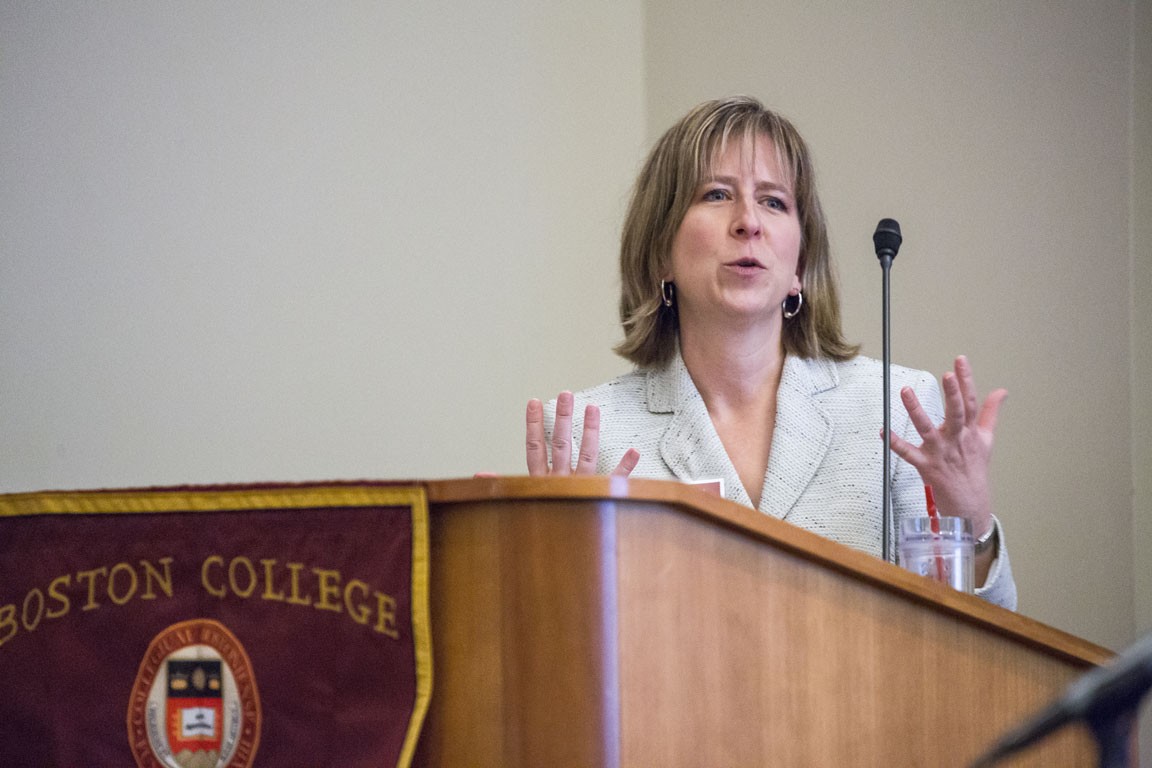Melissa Sutherland was working on a study at a sexually transmitted infections clinic when she met the woman with the broken arm. A research assistant, Sutherland’s job was to interview female patients in order to identify women who had been victims of sexual violence within the previous six months. Those who fit the criteria would be invited to participate in the study. This particular patient said no, she hadn’t been experiencing any violence. Before checking her off as ineligible, Sutherland asked one more question: How did you break your arm?
“Well,” the woman said, “I got pushed down the stairs.”
“I still think about her,” says Sutherland, now an associate professor of nursing at Boston College, seated in her tidy Cushing Hall office. “She had been pushed down the steps by her partner and that’s how her arm got broken. So she was experiencing violence.” Sutherland isn’t sure why the woman initially withheld the truth, but this encounter and others like it helped persuade her that sexual violence is a public health problem that too often goes undetected. These experiences helped to inform her research, which focuses on sexual violence and its impact on women’s health, particularly among female college students.
Sutherland recently received a grant from the National Institute of Child Health and Human Development (NICHD) to pursue her study of violence screening in college health centers, which has become a particularly resonant topic of late. Last year, the National Football League came under fire for failing to adequately punish player Ray Rice for beating his fiancée in a hotel elevator—an episode caught on a hotel security video. Meanwhile, a controversial Rolling Stone article about an alleged gang rape at a University of Virginia fraternity house raised national awareness of sexual violence on campus. Both episodes lend urgency to Sutherland’s goal: finding better ways to identify and help women at risk.

Sutherland was born and raised in upstate New York and graduated from Cornell University with a degree in rural sociology. She went on to study nursing a few hours from her hometown of Goshen, at Binghamton University. She became a clinical instructor at the university’s nursing school, but also took a job treating patients as a nurse practitioner in a sexually transmitted infections (STI) clinic run by the New York State Department of Health. In 2004, Sutherland enrolled at the University of Virginia to pursue a doctorate in nursing. Her advisor was Professor of Nursing Barbara Parker (now retired), a noted authority on violence against women. It was Parker who helped to convince Sutherland to focus her research on what Sutherland called “the intersection between violence and sexual health.” Once Sutherland began to investigate, she discovered that sexual violence is a problem that is often missed—or ignored.
The Institute of Medicine and several major medical organizations in recent years have advised health care providers to screen patients for domestic violence. Yet, as Sutherland would soon discover, those recommendations haven’t been widely embraced in the United States, particularly on college campuses. Surveys indicate that only about one-third of college health centers include questions about sexual consent and sexual violence on routine intake forms—and fewer than half ask about the problem during gynecologic visits.
Sutherland says health care providers are even less likely to inquire about intimate partner violence (IPV), something up to 5.3 million women in the U.S. experience each year. One of Sutherland’s research goals is to find out why doctors and nurses are reluctant to screen women for violence in the same way they might ask about smoking or alcohol consumption. New practice recommendations like these may take time to catch on, she acknowledges. But Sutherland suspects that some health care providers may consider sexual violence to be a private matter and none of their business.
Sutherland's pilot study showed that 36 percent of the 615 female students interviewed had been subjected to intimate partner violence or sexual violence.
Yet, Sutherland is quick to note that victims of IPV and sexual violence are at risk for injury, death, STIs, unintended pregnancy, and psychological distress. Studies show that these women also have increased rates of chronic pain, gastrointestinal disorders, migraine headaches, anxiety, depression, and posttraumatic stress disorder. Failing to screen for sexual violence, Sutherland says, represents “a missed opportunity” to improve women’s health.
The most frequent victims of rape and sexual assault are women between 18 and 24, Sutherland observes. Some research has suggested that female college students are more at risk than nonstudents, but a 2014 Department of Justice study challenged that assertion. To Sutherland, debating whether campuses are the sites of more or less sexual violence distracts from the real problem. “The fact is, women in college are still at risk,” she says.
Sutherland received her doctorate from the University of Virginia in 2008 and arrived at Boston College a year later. Since then, she has fixed her sights on broadening and deepening her understanding of the experience of IPV and sexual violence among college women. Last year, she completed a pilot study in which she interviewed 615 female seniors at two universities in the United States northeast. She found that 36 percent reported they had been subjected to IPV or sexual violence in their lifetime—and that eight percent of the women she interviewed said they had been victims at the hands of a current or former partner within the previous six months. The vast majority of those who had visited their campus health center said they had not been asked about sexual violence.
With her recent NICHD grant, Sutherland is expanding this research in a study of 1,000 female students at five colleges in Massachusetts and New York who have visited their campus health centers within the last three months. Sutherland will also ask health care providers on those five campuses to describe not only their screening practices but their attitudes and beliefs about screening for sexual violence. She plans to complete the study in 2016. “The findings from Melissa’s study are going to give us a much richer understanding of what’s actually going on in practice,” says M. Katherine Hutchinson, an associate dean at the Connell School of Nursing. A few researchers have investigated the violence-screening practices of college health centers in the past, she says, but combining the perspectives of providers and their patients—college women—will offer unique and valuable insights: “That kind of information is going to guide recommendations about how to redesign practice.”
For Sutherland, that means identifying and eliminating barriers that keep providers from screening college women for sexual violence. After all, she asks, what’s the point in doing research unless it can help produce better patient care? Tacked to the bulletin board in her office since her first week at Boston College is a yellow sticky note imprinted with the words So…. what? “You have to be able to answer that question for your work to be meaningful,” she says.

Sutherland’s mind seems to have a hard time staying still; in conversation, she’s lively and energetic, leaping from one idea to the next. That vitality infuses her teaching style too. “Students rave about her,” says Hutchinson. In 2014, she introduced a new course, Public Health in a Global Society, which proved so popular it had a lengthy wait list when it was offered this semester. Sutherland, who is coteaching the course with social epidemiologist Summer Hawkins of the Graduate School of Social Work, is also involved in an effort to develop an interdisciplinary public health minor at the University.
Sutherland has mixed feelings about the recent controversy at the school that awarded her doctorate, U.Va. Last fall, a Rolling Stone feature article recounted the harrowing experience of a woman who said she was sexually assaulted and beaten by a group of fraternity brothers. Neither the reporter nor the magazine corroborated key claims in the story, and details emerged that called into question the woman’s credibility. On the one hand, Sutherland was frustrated by the media’s focus on whether the young woman had lied. “That distracts from the real issue, which is that this continues to be a problem for women,” says Sutherland. Yet the U.Va. story, like the Ray Rice controversy, has a silver lining, she says. “People are talking about violence against women in a way we’ve never spoken about it.”
Sutherland hopes her work will help health care providers, especially nurses, become a bigger part of that conversation. “Asking women about violence in their lives says that you care,” she insists. “If we don’t address it, we’re telling patients that it doesn’t matter. Violence does matter.”
—Timothy Gower, photographs by Lee Pellegrini and Caitlin Cunningham



